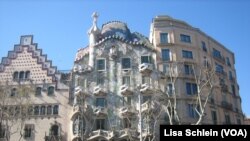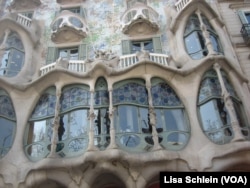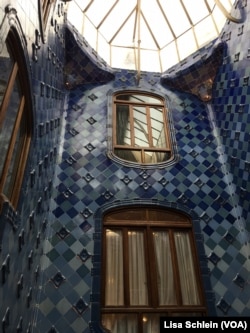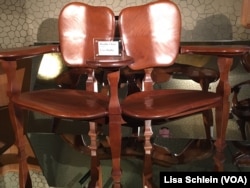Seven works by the Catalonian architect Antoni Gaudi make up a UNESCO World Heritage Site around Barcelona.
One of those properties is Casa Batllo, a building locally referred to as the House of Bones because of its organic skeletal qualities. It figures prominently in celebrations held April 23 for St. George, the patron saint of Catalonia.
The enormous ceramic dragon curled up on the rooftop, with the towering cross of St. George looming over it, ensures Casa Batllo’s playful participation in this annual event. Last year’s sound and light show depicted the convulsive awakening of the snoring dragon.
Legend has it that after St. George slew the dragon to save a princess from its clutches, he plucked a red rose for her from a nearby bush where the dragon’s red blood was spilled.
Casa Batllo plans to use this part of the legend to dress up the façade of the building with very large red roses for this year’s festival.
Ruth Alonso, marketing executive for Casa Batllo, said no other color will do as red signifies the blood of the dragon.
“It is the Day of the Rose as well," Alonso said. "The tradition is that the boys give a rose to the girl and the girls give a book to the boys.
"It used to be that the girls gave the legend of St. George on a book, but now it is also the Day of the Book because all the big writers they wait until that day to do the launch of the books and they are in the streets signing the books," she added.
In 1904, Gaudi was hired by wealthy textile merchant Josep Batllo to refurbish the house.
Batllo's only instruction to Gaudi was to create a spectacular house that would cast all the others on the street into the shade. And, Gaudi obliged.
The architect lavishly employed his love for nature, using color to enhance the brightness and brilliance of this art nouveau structure.
Gaudi's obsession with light is visible throughout the house. A huge central skylight illuminates the dark blue tiles on the upper floors, which gradually lighten and become completely white on the darker bottom floor.
Alonso said the house emphasizes Gaudi’s love for rounded shapes. The windows offer the only straight lines.
Rounded walls
The “Batllo family came here with their furniture. As you can see in the house, everything is round, even the walls are round. So, the family had a problem that they could not fit the furniture because they had a straight line," she said. "So, Gaudi had to design different kinds of furniture for the family.”
Community Manager Pilar Delgado said Batllo’s wife, Amalia Godo, hated the house and hated Gaudi’s suggestion that he design special round furniture for women.
Delgado said Godo did not like the curved design of the house, because it made it very difficult to place furniture in the house. "All the walls are curved back, so it is complicated to live here."
Despite Godo’s disdain for Gaudi’s design, the architect filled the house with sensuous, rounded, extravagantly sculptured furniture in richly colored woods. Because the house attracts a constant stream of visitors, the furniture has been removed to the National Art Museum of Catalonia and the Musee d’Orsay in Paris.
The Batllo family lived on the first floor. The other three floors were rented out to individuals or commercial enterprises.
The dragon, abutted by the cross of St. George, is splayed across the arched rooftop. Its long shape looks menacing because of the creature’s upwardly jutting spiny ceramic scales.
Alonso, the marketing executive, said the floor directly below the roof formerly contained laundry rooms and storage areas for the tenants.
“The dragon is on the top, but we are like inside the dragon," she said. "There was a clothesline as well and all the people from the different places, they used to go upstairs to dry the clothes together.”
PHOTOBLOG: Casa Batllo







